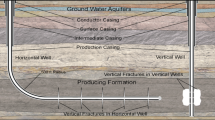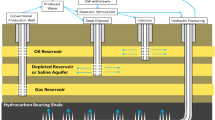Abstract
Subsurface sequestration of CO2 in oil and gas provinces where permanence of hydrocarbon accumulations has proven the reliability of potential traps is rightly seen as a solid option for containment of CO2 atmospheric concentrations. However, one of the most promising provinces for carbon storage in North America, the Texas Gulf Coast, has also been heavily drilled for more than a century, puncturing many otherwise perfectly sound seals (>125,000 wells over ~50,000 km2). As a result, boreholes and, in particular, older abandoned wells could be major leakage pathways for sequestered CO2. This article presents statistics on well spatial and depth distribution that have been drawn from public domain sources and relates these data to historical plugging and abandonment regulations in the Texas Gulf Coast. Surface-well density averages of 2.4 wells/km2 can be locally much higher—but also much lower in larger areas. Average well penetration density drops to 0.27 and 0.05 well/km2 below a depth of 2,440 and 3,660 m, respectively. Natural mitigating factors such as thief zones and heaving “shales” could also play a role in limiting the impact of these direct conduits to the shallow subsurface and surface.










Similar content being viewed by others
References
Bourgoyne AT, Scott SL, Manowski W (2000) A review of sustained casing pressure occurring on the OCS. U.S. Department of Interior, Minerals Management Services, 61p
Clark JE, Bonura DK, Papadeas PW, McGowen RR (2003) Gulf Coast borehole closure test well near Orange, Texas. In: Proceedings of second international symposium on underground injection science and technology, October 22–23, v. LBNL-53837. Lawrence Berkeley National Laboratory, Berkeley
Gasda SE, Bachu S, Celia MA (2004) Spatial characterization of the location of potentially leaky wells penetrating a deep saline aquifer in a mature sedimentary basin. Environ Geol 46:707–720
Gilbert RB, Ward EG, Wolford AJ (2006) Workshop on sustained casing remediation practices. Offshore Technology Research Center, Minerals Management Service, U.S. Department of the Interior, Project No 508
Huerta NJ (2007) Well leakage pathways and their importance to CO2/cement reactions: analysis of long-term cement competence as part of a certification framework for CO2 sequestration. In: Sixth annual conference on carbon capture & sequestration: expediting deployment of industrial scale systems: can it be done? How? Concerns to be addressed, May 7–10, Pittsburgh, Abstract #089
Holloway S (1996) An overview of the Joule II project: the underground disposal of CO2. Energy Convers Manage 37(6–8):1149–1154
Holloway S, Heederick JP, van der Meer LGH, Czernichowski-Lauriol L, Harrison R, Lindeberg E, Summerfield IR, Rochelle C, Schwarzkopf T, Kaarstad O, Berger B (1996) The underground disposal of carbon dioxide: report for the JOULE II Project CT92-0031
Hovorka SD, Doughty C, Holtz MH (2005) Testing efficiency of storage in the subsurface: Frio Brine Pilot experiment. In: Wilson M, Morris T, Gale J, Thambimuthu K (eds) Greenhouse gas control technologies, vol II. Elsevier, San Diego, pp 1361–1372
Hovorka SD, Doughty C, Knox PR, Holtz MH (2004) Capacity assessment of the Frio Formation, Texas. In: The GEO-SEQ Project results, pp 66–70
Ide ST, Friedmann SJ, Herzog HJ (2006) CO2 leakage through existing wells: current technology and regulations. In: Proceedings of 8th international conference on greenhouse gas control technologies, IEA Greenhouse Gas Programme
IPCC (Intergovernmental Panel on Climate Change) (2005) Special report on carbon dioxide capture and storage. Cambridge University Press, Cambridge
Johnston OC, Knape BJ (1986) Pressure effects of the static mud column in abandoned wells. Texas Water Commission, Austin, TX, USA, 99 p
McNeill DF (2000) A review of upward migration of effluent related to subsurface injection at Miami-Dade Water and Sewer South District Plant. Final report prepared for the Sierra Club—Miami Group, 30 p
Nicot J-P, Saripalli P, Bouroullec R, Castellanos H, Hovorka SD, Lakshminarasimhan S, Paine J, Yang Y (2006) Development of science-based permitting guidance for geological sequestration of CO2 in deep saline aquifers based on modeling and risk assessment. Report prepared for the U.S. Department of Energy by the Bureau of Economic Geology and Pacific Northwest National Laboratories, 216 p
NRC (National Research Council) (2006) Surface temperature reconstructions for the last 2,000 Years. The National Academies Press, Washington D.C., 141 p
Paine JG, Dutton AR, Blum MU (1999) Using airborne geophysics to identify salinization in West Texas. The University of Texas at Austin, Bureau of Economic Geology Report of Investigations No. 257, 69 p
RRC (Railroad Commission of Texas) (2000) Well Plugging Primer
RRC (Railroad Commission of Texas) (2007) http://www.rrc.state.tx.us/, last accessed, June 2008
Smith DK (1976) Cementing: society of petroleum engineers, vol 4. AIME Monograph, New York, 184p
Smith DK (1993) Handbook on well plugging and abandonment. Pennwell Publishing Company, Tulsa, 399 p
Warner CA (1939) Texas oil and gas from 1543, 1966 reprint of the original edition. Gulf Publishing Company, Houston, 487p
Warner DL (2001) Technical and economic evaluation of the protection of saline ground water under the safe drinking water act and the UIC regulations: report to the Ground Water Protection Research Foundation, 44 p
Warner DL, Koederitz L, Dunn-Norman S, Laudon RC (1996) Application of an AOR variance methodology to the Permian Basin, Texas: prepared for The American Petroleum Institute, 288 p
Warner DL, Koederitz L, Laudon RC (1997) Application of an area-of-review (AOR) Concept to the East Texas field and other selected Texas Oilfields. University of Missouri-Rolla, Final Report for U.S. Department of Energy Grant No DE-FG22-94MT-94002, 402 p
Watson TL, Bachu S (2007) Evaluation of the potential for gas and CO2 leakage along wellbores: Society of Petroleum Engineers paper No 106817
Wilson EJ, Friedmann SJ, Pollack MF (2007) Research for deployment: incorporating risk, regulation, and liability for carbon capture and sequestration. Environ Sci Technol 41:5945–5952
Acknowledgments
This work was prepared with partial support of the US Department of Energy, under Award No. DE-FC25-04NT42210. However, any opinions, findings, conclusions, or recommendations expressed herein are those of the authors and do not necessarily reflect the view of the DOE. Additional funding was provided by the Jackson School of Geosciences, The University of Texas at Austin, and the Gulf Coast Carbon Center, Bureau of Economic Geology, The University of Texas at Austin. The paper also benefited from a thorough editing by Lana Dieterich. Publication was authorized by the Director, Bureau of Economic Geology, The University of Texas at Austin.
Author information
Authors and Affiliations
Corresponding author
Rights and permissions
About this article
Cite this article
Nicot, JP. A survey of oil and gas wells in the Texas Gulf Coast, USA, and implications for geological sequestration of CO2 . Environ Geol 57, 1625–1638 (2009). https://doi.org/10.1007/s00254-008-1444-4
Received:
Accepted:
Published:
Issue Date:
DOI: https://doi.org/10.1007/s00254-008-1444-4




